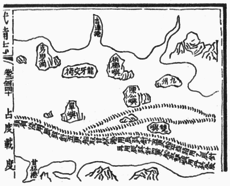Langkawi had long been at the periphery of, but closely associated with, the domain of the old kingdom of Kedah. Legend tells of a great snake ular-besar, the custodian of the Langkawi Islands, to which a new king of Kedah must sacrifice a virgin daughter whenever he first ascended the throne, or when a war was declared with another state.[9]
The island of Langkawi was recorded in history by Chinese and other travellers. It was called Long-ya-pu-ti (龍牙菩提) by the Yuan Dynasty traveller Wang Dayuan , and when the Ming Dynasty admiral Zheng He visited the region he marked the island as Long-ya-jiao-yi (龍牙交椅). In the 15th century, it was known to Acehnese as Pulau Lada or Pepper Island as they came over to plant pepper. In 1691, the French general Augustin de Beaulieu recorded going to the island of "Lancahui" (Langkawi) to buy pepper,[7] and Beaulieu was required to obtain a license from Kedah's heir apparent then in Perlis before the penghulu or chief of Langkawi would sell pepper to him.[10]
Langkawi was historically home to seafarers, such as the Orang Laut (sea people) originally from the southern part of the Malay peninsula, as well as pirates and fishermen. It had been thought to be cursed for a couple of centuries - according to local legend, in the late 18th century, a woman named Mahsuri was wrongfully accused of adultery and put to death, and she placed a curse on the island that would last for seven generations.[11] Not long after Mahsuri's death, in 1821, the Siamese army invaded Kedah, and attacked Langkawi. In the first attack, the locals decided to burn down the granary atPadang Matsirat to starve and drive out the Siamese army. The Siamese nevertheless finally captured the island in May 1822, killed its leaders, and many of the islanders were taken as slaves, while others were forced to flee.[12] Before the Siamese invasion, there was an estimated island population of 3,000–5,000, and only a small proportion was left after the invasion.[13]
The island was recaptured from Siamese rule in a campaign against the Siamese in 1837. In 1840–1841, the Sultan of Kedah, who went into exile after the Siamese attacks, was allowed to return by the Siamese, and the population of Langkawi islands recovered afterwards mainly due to settlement of immigrants from Sumatra. However, the Orang Laut who fled after the Siamese attacks did not returned.[14] In 1909, the islands came under British rule under the Anglo-Siamese Treaty of 1909. The middle of the channel between Tarutao and Langkawi would become the Siamese border, and Tarutao would be part of Siam while all the Langkawi islands to the south would come under British rule. During the Second World War, Siam took control briefly as Malaya fell to the Japanese.
Langkawi had been a haven for pirates which affected the northern part of the Malacca Strait. In a series of operations, between December 1945 and March 1946, the British cleared the pirates' land base in Langkawi and Tarutao.[15] The British continued to rule until Malaya gained its independence in 1957.
Langkawi remained as a quiet backwater until 1986, when the then Prime Minister Mahathir Mohamad decided to transform it into a major tourist resort, helping to plan many of the islands buildings himself.[16] The island rapidly grew as a tourist destination, and by 2012, it had received over 3 million tourists a year.[17][18]

Its a interesting and awesome blog. COMMODITY TIPS FREE
ReplyDeleteSURE SHOT MCX TIPS